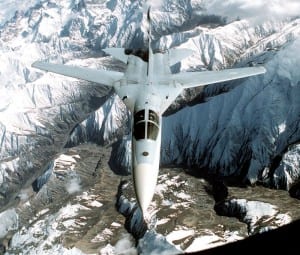Around midnight, Jan. 16, 1991, hundreds of afterburner flames stabbed the inky darkness at many airfields in Saudi Arabia and other countries around Iraq as Operation Desert Storm began.
Among the units vaulted into combat was the Upper Heyford, United Kingdom-based 20th Tactical Fighter Wing (20th TFW), equipped with strike and electronic warfare, General Dynamics F-111s, affectionately known as “Aardvarks.” The EW version was called “Sparkvark.”
The 20th TFW had aircraft deployed at Incirlik Air Base, Turkey, for a weapons training deployment in August 1990, when Iraq invaded Kuwait and Operation Desert Shield, the containment of Iraq, began. As the start of the air campaign neared, the wing reinforced its presence at Incirlik. The wing also deployed four 42nd Electronic Combat Squadron EF-111As and 80 personnel to Taif, Saudi Arabia, as the United Nations’ deadline for Iraq’s withdrawal neared.
The first munitions hit Iraqi emplacements at 2:38 a.m. On the first day of combat, Iraq felt the impact of more than 2,000 sorties from the Allied Air Coalition, more than they had experienced in eight years of war with Iran.
First Kill

An EF-111 Raven makes the approach for an in-flight refueling mission in support of a no-fly zone north of the 36 degree parallel from Iraqi air and ground incursion after the conclusion of Operation Desert Storm. DoD photo
On Jan. 16, before Desert Storm actually began, an unarmed 42nd ECS EF-111A crew accomplished the first aerial kill of the war. The Sparkvark was attacked by an Iraqi Mirage fighter while flying at night near the Saudi/Iraq border. To try to defeat the Iraqi fighter, the ‘Vark pilot descended at very high speed to minimum altitude using the jet’s terrain-following radar (TFR). While trying to follow the F-111, which excelled at low-altitude, high-speed flight, the unfortunate Iraqi pilot slammed into the ground.
Combat
A few hours later, on Jan. 17, 20th TFW aircraft launched combat missions from both Turkey and Saudi Arabia. Attacks continued until the cease-fire on Feb. 28. The F-111s flying from Turkey flew night missions throughout the war, using the TFR to penetrate the dense anti-aircraft artillery (AAA) environment at altitudes around 200 feet for the first few nights.
Crews who flew those first few terrifying nights said that the illumination from the AAA was so bright that they didn’t need the TFR to avoid the ground.
First, the wing’s F-111Es raced into Iraq at low level to destroy four radar sites in northern Iraq and open an electronic gate. The sky was overcast at 3,000 feet with visibility at 3 miles with fog. Despite the poor weather, the 20th crews encountered little Iraqi resistance, found the targets, and delivered their ordnance. These and subsequent missions forced Iraqi commanders to contend with attacks from all directions and to respond to a second air front as well as a potential second ground front.
Within a few days, Wild Weasel F-4G Phantoms from Spangdahlem Air Base, Germany, had all but eliminated surface-to-air threats. After the missile threat was suppressed, crews flew their attacks at altitudes around 20,000 feet, above the range of most Iraqi AAA guns.
On Jan. 25, 1991, the wing grew to four flying squadrons when the 42nd ECS was officially reassigned to the 20th from the 66th Electronic Combat Wing.
During the war, the F-111s attacked a range of targets, including power plants, petroleum refineries, airfield, nuclear, biological, chemical processing and storage facilities, and electronics sites throughout northern Iraq using 500- and 2,000-pound conventional bombs, and CBU-87/89 cluster bombs. Wing EF-111As flew both day and night missions, providing direct and stand-off jamming for all coalition air forces. The skill and conspicuous bravery of wing aircrews was recognized in the award of numerous Silver Stars, Distinguished Flying Crosses, and Air Medals.
Home-base participation
Back at home base, RAF Upper Heyford was designated as the Regional Evacuation Control Center. Also, in the first six months of 1991, transient alert personnel, in support of Desert Storm, serviced and launched the largest number of transient aircraft in the history of RAF Upper Heyford: 1,408 aircraft.
Then on March 9, 1991, 27 of the 28 deployed F-111Es and EF-111As, along with the support personnel, returned home from Incirlik Air Base.
Final score
By the end of the conflict, Saudi-based EF-111As had flown 219 combat missions, totaling 1,155 flying hours. The wing’s six EF-111As based in Turkey flew 252 combat missions, totaling 704 hours, while the 23 F-111Es at Incirlik flew 456 combat missions, a total of 1,327 combat hours. The wing had deployed 458 personnel, flown 1,798 combat sorties without a loss, and dropped 4,714 tons of ordnance.
(Adapted from the history of the 20th Fighter Wing, by Art Sevigny, 20th FW historian, and other sources.)



li class="comment even thread-even depth-1" id="comment-16202">
tmeedel
10:59 AM November 17, 2011
Hey,
Thanks for the update, I was a crew chief on 68-004 from the 55th TFS , 20th TFW, RAF Upper Heyford.
I got disabled in an car accident and was out processing when we pulled the WTD to Incerlik.
I am glad to hear we lost no Aircraft or Aircrews.
I believe they have the “Chief” at the Pima Air Museum in Tucson AZ…..
Todd Meedel